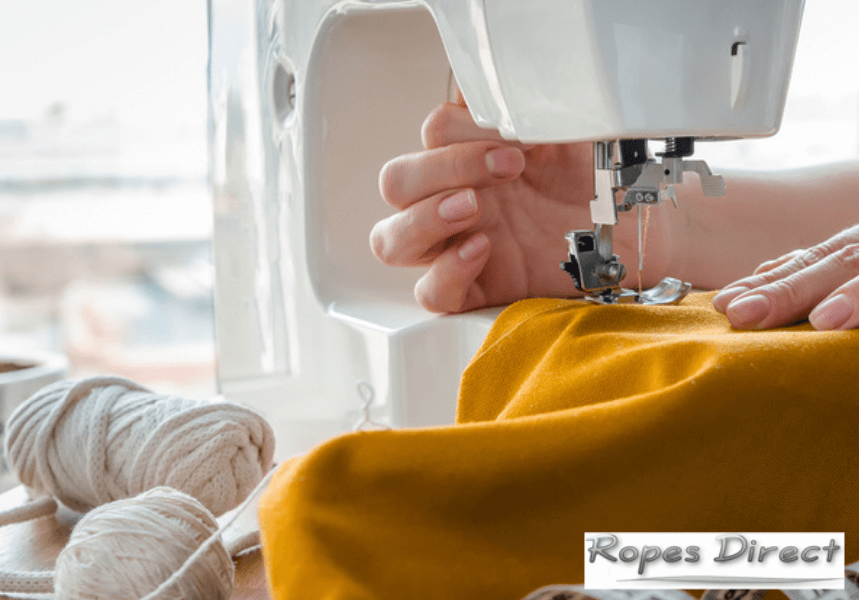Learn a new skill.
It’s set to be one of the most popular New Year’s Resolutions for 2022. In fact, lots of people are keen to try their hand at the ‘lost art’ of sewing – and now is the perfect time to get started!
Here at RopesDirect, we’ve recently ventured into the world of haberdashery, launching a new collection of cotton piping cords. Due to their 3-strand construction, these are a great choice for crafters – and can be used to create clothes, accessories (e.g. drawstring backs) and soft furnishings such as pillows and cushions.
We’re by no means experts on this topic, but to give you a helping hand, here we’ve rounded up a few simple tips on how to start sewing and master your first project.
So why not have a go? Set aside a few hours in January and get creative!
5 simple steps to learn how to sew
1. Invest in a sewing machine
First things first, you’re going to need a sewing machine.
For a beginner, our advice is to ask a friend if you can use theirs. After all, how many times have you started a hobby in the new year, just to lose interest by February? By borrowing a machine, you can have a go – without the commitment (or expense!) – and decide whether it’s for you.
If you’d prefer to buy your own, try not to get too bogged down in the different types available. Essentially, all you need is a machine that has a straight stitch and an adjustable zigzag stitch. That’s it. And we recommend opting for a full-sized, rather than a mini or portable model.
2. Stock up on haberdashery supplies
In addition to a sewing machine, it’s a good idea to have a few basic sewing supplies.
To learn to sew successfully, you’re likely to need a pair of fabric scissors, a tape measure, a seam ripper (to unpick those inevitable ‘beginner’ mistakes) and chalk pencils for marking. You should also stock up on some key haberdashery items, such as buttons, sewing threads, pins, and piping cords.
These are all relatively cheap to buy. Our cotton piping cords start from just £9.72 for a 950gm spool, and the rest can be picked up online for a fair price. So you can fill up your sewing box on a budget and make sure you have all the tools necessary to become a master sewer.

3. Familiarise yourself with the sewing machine
As a beginner, just getting your machine fired up and ready to sew can be a challenge. So, before you choose your first pattern, spend a little time getting to know your machine.
Make sure you understand how to set it up. Learn how to raise and lower the presser foot. And have a go at threading the machine. Once you’re familiar with how everything works, it’s also a great idea to practice some basic stitches on a scrap piece of fabric. Just take your time and mind your fingers!
4. Do some ‘beginner’ reading
Thousands of books on ‘how to start sewing’ are available to buy. But if you’d prefer to minimise the cost of your new hobby, there are many excellent sewing blogs, which offer beginner sewing tips and step-by-step beginner patterns – often, completely free of charge.
One of our favourites is ‘Tilly and the Buttons’.
The founder of the blog featured on the ‘Great British Sewing Bee’ in 2013 – so, it’s fair to say, she knows her stuff. And the website is jam-packed with helpful ‘Learn to Sew’ posts, jargon-free instructions and photos to help beginners on their way. If you’re serious about becoming a sewer, it’s certainly worth having a look!
5. Choose your first pattern wisely
The big question – what are you going to make first? Our advice is to be kind to yourself and choose a relatively simple pattern. Try to avoid anything too complex or fiddly. And to keep your motivation levels up, make sure it’s something fun – and achievable!
It’s also worth keeping in mind, woven fabrics – such as cotton canvas, denim and chambray – are the easiest to work with. So as a beginner, perhaps look specifically for a pattern that uses one of these. And avoid materials such as silk, chiffon and knits (which are notoriously hard to sew!).

Stock up on piping cord and start sewing this January
Whether the pattern you’ve chosen uses cotton piping cord or not, it’s a great supply to have in your sewing box. Our new range features piping cords in 3-5mm diameters. So there’s something to suit many different projects – and they’re all high-quality, competitively priced and ready for dispatch.
If you do use our piping cords in your sewing endeavours, be sure to send us some photos of your handiwork. We always love to see our products in action and it’s a great way to show off your new sewing skills. Either send a photo to info@ropesdirect.co.uk and we’ll post them on our Facebook page or tag us on social media using @RopesDirect.

